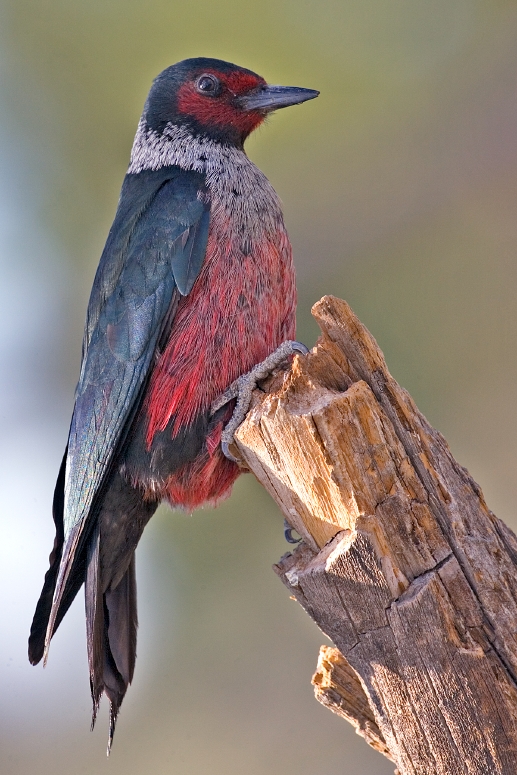Sporting shimmering green wings that stretch out to a 20-inch wingspan, a ruby-red face and a bright-pink chest, at first glance the Lewis’s Woodpecker almost looks like an over-sized hummingbird. Named after the co-leader of the Lewis and Clark expeditions, this woodpecker maintains a year-round presence in Northern New Mexico, and the summer months are a perfect opportunity to see them in the wild as they cease their nomadic behavior in favor of settling down for breeding season.

You’re most likely to find these woodpeckers out in open woodland areas, especially ones with streams or other bodies of water that attract insects. Lewis’s Woodpeckers don’t do a great deal of pecking wood despite their name. While they will occasionally burrow into decaying or dead tree bark to reach their insect meal inside, primarily they keep themselves fed during summer months by perching on a tree branch and swooping down to gobble insects mid-flight, much like flycatchers. They also prefer woodland areas due to the free housing left for them by other woodpeckers, nesting in the holes burrowed in bark by other beaks during their breeding season. Once a suitable burrow is found, the monogamous couple will furnish it with wood-chips and take turns incubating their eggs for 12 days. The parents share feeding responsibilities until their fledglings are deemed ready to leave the nest, usually in about a month or so. Afterward the couple resumes their nomadic lifestyle before returning to the same burrow, assuming it’s still unoccupied, the following season to produce more offspring.
While females typically lay between 6-8 eggs each breeding season, that hasn’t been nearly enough to keep up with rampant habitat destruction that’s resulted in a population decline of 72 percent between 1970 and 2014. While work is being done at the state level to protect the forests that Lewis’s Woodpeckers and many other species depend on, an increase in global temperatures will mean further degradation of habitat in the form of forest fires and heatwaves, which can kill nestlings. Conservationists recommend leaving dead trees standing to alleviate this habitat loss, so long as the tree doesn’t pose a threat to an existing structure.
Backyard birders can also offer a rest stop for these birds by providing suet cakes in their feeders. I’ve personally found peanut butter based recipes to be a particular favorite among the woodpeckers, and this is probably the easiest way to see them in their wild beauty. Sometimes I’ve been graced with three Lewis’s Woodpeckers at once, all chirping about and discussing whatever it is birds talk about in their songs. Be warned though, once one of these birds makes your yard a regular stop, they’ll become quite territorial and chase other birds away from “their” suet feeder. The Lewis’s Woodpecker isn’t afraid to throw its substantial size around when it comes to protecting its food: I’ve seen one woodpecker chase off multiple magpies from a feeder he wasn’t even eating from. Having multiple suet feeders spaced far apart can help reduce this conflict.
The Lewis’s Woodpecker really is a sight to behold. Rarely does such a large bird embody such striking colors as this, and its aerial acrobatics as it catches insects are dazzling. Current projections for global temperature increases put us around 2.5°C by 2100 in a good scenario, which would destroy most of their habitat here in New Mexico and force them to move into new habitats further north. We can each individually do small actions like supplying accessible food and letting dead trees stand, but these noble deeds won’t correct global arson. If you want your grandchildren to see the Lewis’s Woodpecker in New Mexico, your best bet is to take a picture.
Author
-

Bryce Flanagan moved from Sacramento, CA to Taos County in 2016, and has lived in Questa for two years. He's passionate about the unique and beautiful wildlife of our state and is a regular contributor to the Questa Del Rio News.
View all posts



